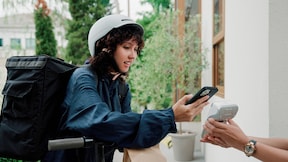Credit card basics
Credit cards can be useful when needed, but you can get the biggest benefits when you understand the basics of credit.
Learning about the basics of credit
credit card basicsManaging your credit in a gig economy

With the rise of short-term, flexible jobs like ridesharing and freelancing, managing your credit can be important. Discover tools to help leverage your credit card.
credit card basicsHow business credit cards may affect your personal credit score

Most banks run a hard credit check on your personal credit report when you apply for a business credit card. Learn information to help you know what to expect when you apply for a card.
credit card basicsManaging pet expenses with a credit card

Find out how to use credit cards for pet care, earn rewards, manage budgets and avoid interest pitfalls. Make informed financial choices for your pet's expenses.
Learn ways to use your credit card wisely
credit card basics
Managing your credit in a gig economy With the rise of short-term, flexible jobs like ridesharing and freelancing, managing your credit can be important. Discover tools to help leverage your credit card.
With the rise of short-term, flexible jobs like ridesharing and freelancing, managing your credit can be important. Discover tools to help leverage your credit card.credit card basics
Managing pet expenses with a credit card Find out how to use credit cards for pet care, earn rewards, manage budgets and avoid interest pitfalls. Make informed financial choices for your pet's expenses.
Find out how to use credit cards for pet care, earn rewards, manage budgets and avoid interest pitfalls. Make informed financial choices for your pet's expenses.credit card basics
Is getting preapproved for multiple credit cards a good idea? Wondering if getting preapproved for multiple credit card offers is a good idea? Learn the potential benefits and drawbacks of making an informed decision.
Wondering if getting preapproved for multiple credit card offers is a good idea? Learn the potential benefits and drawbacks of making an informed decision.credit card basics
How to teach your child about credit card fraud Teaching children about credit card fraud can be a helpful step in mitigating the risk of fraud. Here are ways fraud can happen and how to help prevent it.
Teaching children about credit card fraud can be a helpful step in mitigating the risk of fraud. Here are ways fraud can happen and how to help prevent it.credit card basics
A guide to credit limit transfers Explore credit limit transfers and ways you may be able to leverage one to your advantage.
Explore credit limit transfers and ways you may be able to leverage one to your advantage.credit card basics
How to recover from a late credit card payment Missed a credit card payment? Depending how long it's been, you still have some time before it appears as a negative mark on your report. Learn how to recover from a late payment.
Missed a credit card payment? Depending how long it's been, you still have some time before it appears as a negative mark on your report. Learn how to recover from a late payment.credit card basics
Teaching your child the difference between debit and credit cards Learn ways to educate our child on the key differences between debit and credit cards, empowering them with essential financial knowledge for their future.
Learn ways to educate our child on the key differences between debit and credit cards, empowering them with essential financial knowledge for their future.credit card basics
What to do after you’ve been preapproved for a credit card Find out what to do next after getting preapproved for a credit card. Learn the steps to finalize your application and improve your chances of approval.
Find out what to do next after getting preapproved for a credit card. Learn the steps to finalize your application and improve your chances of approval.
Explore financial education